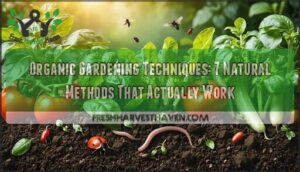This site is supported by our readers. We may earn a commission, at no cost to you, if you purchase through links.
Your garden’s soil contains more living organisms in a single teaspoon than there are humans on Earth—billions of bacteria, fungi, and microorganisms working together to create the foundation of plant health. Yet conventional farming practices often treat soil like an inert substance, relying on synthetic inputs that can disrupt this hidden ecosystem.
Research shows that organically managed soils contain 41% more microbial biomass than conventionally treated plots, and this difference translates directly into stronger plants, better yields, and improved water retention. When you shift to organic methods for healthy soil, you’re not just avoiding chemicals—you’re actively rebuilding a living system that becomes more productive year after year.
The practices that support this transformation range from simple composting techniques to strategic crop rotations, each one working to feed the soil organisms that, in turn, feed your plants.
Table Of Contents
Key Takeaways
- Organically managed soils contain 41% more microbial biomass than conventional plots, translating directly into stronger plants, better yields, and improved water retention through billions of bacteria, fungi, and microorganisms working together.
- Boosting soil organic matter by just 1% can increase crop yields by 10–23% while fighting erosion and improving nutrient availability, making it the foundation of productive organic farming systems.
- Combining practices like composting, cover cropping with nitrogen-fixing legumes, and reducing tillage creates a self-sustaining ecosystem that becomes more fertile and resilient year after year without synthetic inputs.
- Regular monitoring of soil structure, drainage, and microbial activity allows you to track progress and adjust practices, with meaningful improvements typically visible within 2–5 years and full soil health transformation achieved in 5–10 years.
Why Healthy Soil Matters Organically
When you farm organically, soil isn’t just dirt—it’s the foundation of everything that grows. Rich, living soil determines whether your plants thrive or struggle, and it shapes the long-term productivity of your land.
Let’s look at three key reasons why building healthy soil matters so much in organic systems.
Benefits of High Organic Matter
Think of organic matter as your soil’s secret weapon. When you boost it by just 1%, your crop yields can jump 10–23%. You’ll see better water retention, especially in sandy soils, and nutrients like nitrogen stay available when plants need them. Plus, you’re fighting erosion while capturing carbon—healthier soil really does mean healthier crops and a healthier planet.
This is because organic matter behaves like a sponge, holding significant water.
Role of Soil Microorganisms
Organic matter’s real power comes from the billions of tiny workers it feeds: soil microorganisms. Your organic soil hosts diverse bacteria, fungi, and archaea that free up nutrients plants can actually use. These beneficial microbes don’t just cycle nitrogen and phosphorus—they also produce growth hormones and fight off pathogens. Research shows organically managed soils have 41% more microbial biomass than conventional fields, giving you:
- Stronger nutrient cycling that feeds your crops naturally
- Better disease suppression protecting plant roots
- Improved soil structure holding everything together
- Enhanced ecosystem resilience against environmental stress
- Greater microbial diversity supporting long-term soil health
That microbial activity translates directly into healthier, more productive gardens and farms. Soil microbes perform vital functions in the soil ecosystem.
Soil as a Living Ecosystem
When you recognize soil as a living ecosystem rather than inert dirt, everything changes. Soil biodiversity rivals rainforests—nearly two-thirds of Earth’s species actually live underground.
Soil is a living ecosystem whose biodiversity rivals rainforests, hosting nearly two-thirds of Earth’s species underground
This complex web of microorganisms, fungi, and countless other creatures drives nutrient cycling, carbon sequestration, and ecosystem resilience. Microbial activity within soil food webs creates the foundation for thriving plants, proving that soil health starts with honoring this hidden world beneath your feet.
Best Organic Methods for Soil Health
Building healthy soil starts with practices that feed the living organisms beneath your feet, not just the plants above them. The most effective organic methods work together to increase organic matter, protect soil structure, and support a thriving microbial community.
Let’s look at three foundational approaches you can use to transform your soil into a productive, resilient ecosystem.
Composting Techniques
You’ll improve your soil’s fertility and structure dramatically by mastering a few composting techniques. Start with thermophilic composting, which heats piles to 55–60°C for rapid pathogen kill-off and quicker compost maturity. Maintain a C:N ratio around 25:1 to balance decomposition speed with nutrient retention. Turn your pile regularly for proper compost aeration, or try vermicomposting for smaller spaces.
These organic amendments boost soil health by increasing organic matter and beneficial microorganisms.
Using Green Manures and Cover Crops
When you plant green manures and cover crops, you’re creating a living system that addresses multiple soil challenges at once. These seasonal plantings deliver powerful results:
- Erosion prevention through root networks and surface protection
- Weed suppression by forming dense canopies that block sunlight
- Nitrogen fixation in soil from legumes adding 110–500 pounds per acre
- Water retention improvements through increased organic matter
- Nutrient cycling enhancement via microbial activity and enzyme production
Your soil structure benefits immediately from their decomposing biomass and deep roots.
Reducing or Eliminating Tillage
When you minimize soil disturbance, you’re protecting the underground infrastructure your plants depend on. No-till gardening and reduced tillage practices cut erosion by up to 90% while boosting carbon sequestration at 57 grams per square meter yearly. Here’s what conservation tillage delivers for climate mitigation and microbial health:
| Benefit | Impact |
|---|---|
| Erosion reduction | 70–90% decrease in soil loss |
| Carbon sequestration | Doubles stable soil carbon after 10–13 years |
| Microbial health | 30–45% higher moisture retention bolsters diverse communities |
| Yield impact | 7–12% increase during drought after adjustment period |
Your soil structure stays intact, water infiltrates better, and beneficial organisms thrive in their undisturbed habitat.
Enhancing Soil Fertility Naturally
Building fertile soil doesn’t require synthetic chemicals—nature provides everything you need. By tapping into biological processes like nitrogen fixation and fostering beneficial fungal partnerships, you can create a self-sustaining system that feeds your plants year after year.
Let’s look at three powerful ways to boost soil fertility using organic methods that work with your soil’s natural ecosystem.
Nitrogen Fixation From Legumes
Legumes work like tiny nitrogen factories in your soil, partnering with rhizobia strains to convert atmospheric nitrogen into plant-available nutrients.
To achieve the best fixation efficiency, follow these steps:
- Employ legume inoculation to guarantee thriving bacterial colonization in your root nodules
- Choose diverse cover crops such as clover or vetch that can supply 100-300 kg nitrogen per hectare annually
- Limit fertilizer impact since excessive synthetic nitrogen reduces nodule formation by 20-30%
This natural process builds organic matter and sustains soil health season after season.
Mineral Amendments and Natural Fertilizers
Organic amendments like compost and manure have impacts beyond nitrogen delivery—they improve soil porosity, support beneficial microbes, and build lasting fertility.
Mineral amendments such as biochar benefit your soil by raising available potassium up to 74%, while fulvate effects include boosting phosphorus by over 800%.
These natural fertilizers and soil amendments strengthen sustainable farming without harsh synthetic inputs.
Boosting Mycorrhizal Fungi Populations
You can boost mycorrhizal fungi populations through four straightforward practices. Compost enhancement at moderate rates increases AMF colonization and spore density. Cover cropping with cereal rye or clover preserves beneficial fungi networks between cash crops. Reduced tillage protects the delicate hyphal threads that conventional plowing destroys.
Native inoculation using local fungi species improves colonization efficiency, contributing to yield improvements of up to 40% in field trials.
Sustainable Soil Management Practices
Building healthy soil is just the start—keeping it that way requires thoughtful management over time. The practices you choose shape how well your soil retains fertility, resists pests, and encourages plant growth season after season.
Let’s look at three core strategies that help you maintain thriving soil without compromising its long-term health.
Crop Rotation Strategies
Think of crop rotation as a strategic dance between plants and soil. When you alternate crops with different nutrient needs and root structures, you break pest control cycles while building soil structure naturally.
Rotation diversity boosts yield resilience—studies show maize yields jumping 28% on average. Your soil health thrives through improved nutrient management, making organic farming more sustainable and productive over time.
Mulching for Moisture and Weed Control
A simple layer of organic mulch works double duty in your garden—it locks moisture into soil while choking out weeds.
Research shows mulch water retention can increase soil moisture by up to 82%, and weed suppression rates hit 67% with the right materials.
Sorghum, grass clippings, or newspaper applied at 0.25–0.50 kg/m² deliver these mulch effectiveness mechanisms beautifully, enhancing soil organic matter as they break down.
Integrated Pest and Weed Management
Beyond mulch, you can weave biological controls and mechanical weeding into a single, efficient approach. Crop rotation paired with mulch integration slashes weed density by up to 65%, while beneficial insects deliver a 42% drop in pest populations.
Farmers using Integrated Pest Management report solid weed control methods and improved outcomes, reducing pesticide use by 65% and building resilient soil ecosystems.
Assessing and Monitoring Soil Health
You can’t improve what you don’t measure, and that’s especially true when you’re building healthy soil from the ground up. Regular monitoring helps you see what’s working, catch problems early, and adjust your practices based on real evidence rather than guesswork.
Let’s look at two fundamental ways to assess your soil’s condition and track its progress over time.
Evaluating Soil Structure and Drainage
How do you know if your soil structure is working in your favor? Start with a visual assessment to spot compaction early, then test aggregate stability—values above 80% signal excellent physical quality.
Check infiltration rates to see if water moves freely, and measure penetration resistance since roots struggle when it tops 2 MPa.
Proper drainage impacts yield directly, so monitoring soil aeration and drainage pays off.
Understanding Soil Microbial Activity
Physical tests reveal structure, but microbial communities tell you what’s happening beneath the surface. Microbial nutrient cycling drives fertility, while fungal-bacterial ratios influence plant performance. Beneficial microbes—including mycorrhizal fungi and protistan predation dynamics—respond quickly to environmental impacts.
Monitor soil biodiversity through:
- Biomass distribution in your top 5–10 cm layer
- Soil microorganism populations using enzyme activity tests
- Moisture and carbon levels that fuel microbial communities
Frequently Asked Questions (FAQs)
How long does soil transformation take organically?
Transformation timeframes vary by soil type and practice impact. You’ll see microbial stabilization and organic matter gains within 2-5 years, though reaching stable soil health and biodiversity often requires 5-10 years of consistent organic farming practices.
Can organic methods work in urban gardens?
Cities are sprouting gardens on every rooftop and vacant lot imaginable. Urban composting success demonstrates that space-limited methods can overcome soil contamination risks, creating nutrient-rich, sustainable gardening havens.
These havens improve soil structure, boost plant growth, and strengthen urban food security.
What are signs of poor soil drainage?
Standing water that lingers after rain, yellowing leaves, and mushy root rot signal poor soil drainage.
Soil saturation starves roots of oxygen, increases mold growth, and damages soil structure—all problems you can fix by improving soil aeration and drainage.
How much compost should I apply yearly?
You’ll usually apply 3–8 tons of compost per acre yearly, adjusting for nutrient content and soil testing results.
Application rate factors include compost nutrient availability and soil type impact, preventing over-application risks while building soil organic matter long-term.
Are there downsides to excessive organic matter?
Like icing a cake with a trowel, too much organic matter can smother your soil’s balance.
Nutrient imbalances, drainage issues, pollution concerns, disease risks, and economic impacts all increase when organic amendments exceed ideal levels.
Conclusion
When you dig into organic methods for healthy soil, you’re planting the seeds of a self-sustaining system. Each practice—from composting kitchen scraps to rotating legumes—feeds the microscopic workforce beneath your feet.
These organisms don’t need synthetic shortcuts; they thrive on diversity and organic matter. As microbial populations expand, your soil becomes more resilient, fertile, and alive.
The investment you make today builds momentum underground, creating a foundation that strengthens with every growing season.
- https://edis.ifas.ufl.edu/publication/AG277
- https://www.frontiersin.org/journals/soil-science/articles/10.3389/fsoil.2022.749212/full
- https://agriculture.institute/organic-production-system/crop-rotation-soil-fertility-pest-control-yield/
- https://www.sciencedirect.com/science/article/abs/pii/S0167880924005280
- https://www.organic-center.org/sites/default/files/project/2020/03/soil-health-review_shadetully.pdf










